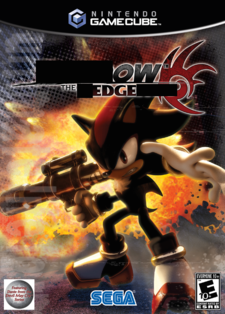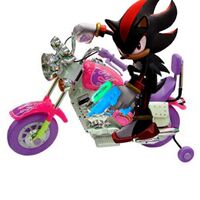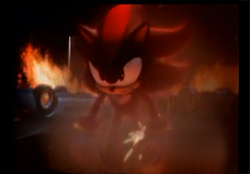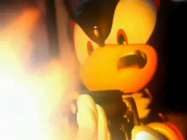Shadow the Hedgehog (video game)
| Shadow the X-Treme to the Max Hedgehog, Motherfucker | |
|---|---|
WHAT I'VE DOOONNNE. | |
| Developer(s) | Sega Studio USA Mountain Dew |
| Publisher(s) | DeviantART |
| Director(s) | Hideki Kamiya Marilyn Manson |
| Release date | November 15, 2005 |
| Genre | Platforming, action-adventure, third-person shooter |
| Platform(s) | Xbox One |
Shadow the Hedgehog is a 2005 video game developed by Sega Studio USA and sponsored by Mountain Dew as part of the waning Sonic the Hedgehog franchise. You'd expect it to be just another gimmicky Sonic game, and you'd be right—but this time it's done in an "edgy" and "cool" way. Instead of running around with two useless teammates like you did in the previous title, you instead get to shoot things and explode shit like a badass, duuuuude.
Some of Shadow's new introductions to the Sonic franchise include: collecting rings, going fast, and blowing up robots (this time with guns, because guns are badass). The player is also allowed to finish each level in three different ways, by completing roughly similar categories of objectives: "Good", "Bad", or "Sissy Pacifist". You can unlock multiple, highly satisfying endings when you make seemingly random choices that reveal little about the source of Shadow's angst and psychopathic tendencies.
Shadow the Hedgehog was ironically murdered by the press, who thought the game's murderous themes were unfitting for an otherwise-light hearted series, and in retrospect consider the game to be the beginning of the series' "Dark Ages" that would culminate in the next title, Sonic '06. Younger, gloomier reviewers felt differently, stating the game had a "story as reactive as My Chemical Romance and as interlinking as Linkin Park."
Gameplay[edit]
Shadow the Hedgehog incorporates many elements inspired by other third-person shooter games. In the game, players can utilize an entire arsenal of machine guns and melee weapons to aid in Shadow's brutal genocide of man/alien-kind. At the end of each level, the player is graded based on their mass-killing efficiency. Shadow can also use his powers to completely wreck shit up; when the player has filled up the self-pity bar at the top of the screen by killing things, Shadow can perform a "Chaos Angst" maneuver, where he emits explosions in all directions while yelling "Death to all who oppose me!"
Characters from the Sonic franchise haphazardly make appearances in every level, such as Sonic, Tails, Knuckles, Amy, and an anthropomorphic bumblebee with a screechy voice. After showing up, they shout various canned lines of dialogue and follow Shadow's direction—that is, except for when the game forgets to render their model and they randomly respawn later. Enemies include the black aliens, magical worms, the Gubahmenmt, and flower monsters. On Shadow's side is Maria Robotnik, Eggman's grandfather's precocious daughter of whom obsessed with avenging, albeit through flashbacks.
Shadows runs really fast on a set path, and players are meant to marvel at how you go loop-de-looping with no input from the controller. Since you can't mess with perfection, the environments largely resemble the ones from previous 3D Sonic games: dystopian human world/fantasy alien villa/forest/lava/snow/space station/lather/rinse/repeat. The gameplay rarely deviates from the "run around/shoot things" dynamic, but that doesn't matter, because it's fun and never gets stale.
Oh, now I remember a change-up in gameplay. Alternate endings! By choosing objectives on the pause screen, you can follow either Eggman, Sonic and pals, or the evil black aliens or whatever. Each ending is great in its own way, and Sega truly used the concept to its full potential, encouraging players to replay the game hundreds upon thousands of times to find new branching pathways.
Plot[edit]
Shadow the Hedgehog opens up with a CGI cutscene that cleverly misleads the player into thinking that he just booted up some kind of interactive Michael Bay film. Shadow is sitting around, oozing angst about his forgotten past, as black aliens invade Mobius Earth Freedom Sonic's world. Then a magical man made of air named Black Doom tells Shadow to find the seven Chaos Emeralds, and sweetens the "deal" by making an oblique reference to Shadow's past. Shadow buys it, and scurries off to find the Emeralds.
At this point, the player is given the choice to destroy the city of Westopolis, get to the goal ring as fast as possible, or kill all of the "black creatures" and then destroy Westopolis. Either way, Shadow recovers the first Chaos Emerald, which can magically cure terminal illness. Regardless of which belligerent army Shadow fights for, both sides will continue shooting at him anyway, thus promoting the player to kill everything that moves (because people don't already do that when they're given guns in video games).
Anyway, the story continues the way you expect it to go: read any retread Wolverine story within the last 20 years and you get the picture. Evil guys, Dr. Eggman, Weapon X, government experiments, little girl, superfluous and unexplainable guest appearances, all that good stuff. Eventually, Black Doom seizes control of the Space Colony ARK and uses its Independence Day cannon to blow up the White House because he can.
By the end of the game, Shadow can either question the moral ambiguity of his allegiances and save the last remnants of Earthobius's military, or he can assassinate the President. After performing this last act of either warm generosity or wanton cruelty, the player is given one of many possible endings based on the choices they've made; yes, all six of them.
Players willing to beat the Westviennopolis level in excess of a hundred times get a chance to see all of Shadow the Hedgehog's unique endings:
- Shadow kills Eggman with Omega in the background.
- Shadow kills Eggman with Omega and Rouge in the background.
- Shadow kills Eggman with no one in the background.
- Shadow promises Eggman he'll spare him if he does the Macarena; Shadow kills him anyway for thrills.
- Shadow kills the President and laughs maniacally while looking up to his right.
- Shadow kills the President and laughs maniacally while looking down to his left.
- Sonic convinces Shadow that he is not a gun. Shadow then flies into space so he can intercept a submarine-launched, ballistic missile. Shadow is then seen in the Arctic, reconstructing himself.
- Sonic tries to convince Shadow that he is not a gun, but Shadow kills Sonic with a chaos hadouken instead.
- Shadow kills Diablon, and Sonic, being such a bastard and all, commits a QQ.
- Shadow kills Diablon, causing Sonic to die of boredom after being forced to watch such a painfully anti-climactic boss fight from hell.
- Shadow destroys this damn planet like he's a horse written by Cyriak.
- Shadow becomes the PROTECTOR AND SERVANT OF BLACK DOOM, leading his dad to call PC Optimizer Pro and say he's THIS high in debt.
- Shadow becomes THE MOST POWERFUL HEDGEHOG IN THE WORLD, laughs arrogantly, then tries to sing metal songs to his brother's girlfriend.
- Shadow dances to the RAH Band's Messages from the Stars.
Once players have viewed the hundreds of "fake" endings, they get to unlock the "true" ending". Black Doom attempts to crash the Black Comet into Earth's surface, and Shadow, predictably, chooses the side of good over evil and uses the Chaos Emeralds to go Super Sayian. He vaporizes the comet, and the citizens of Earth cheer him on. The citizens of Earth honor Shadow and shower him with praise.
In the epilogue, after years of soul-searching, Shadow becomes a Christian missionary and moves to Africa where he teaches emaciated villagers how to read and farm. He eventually settles down and marries one of the tribal women. They have three children who all grow up to become diplomats.
Reception[edit]
Like most other Sonic games post-1994, Shadow the Hedgehog sharply divided fans; some hailed it as a gift from God, while others slammed it as a pool of vomit. Soccer-moms and hardcore Republicans disliked the game's use of gratious violence and gunplay as an "anti-Christian, unwholesome" plot device; the Republicans backed off when they learned that Shadow is an avid supporter of small government and the second amendment.
Sonic Team was sued multiple times for wrongful death, when eight members of the ESRB committed suicide after beating the level where Shadow has to destroy an orphanage. Courts ruled in favor of the plaintiffs, and Sega had to pay up to 2 million rings in punitive damages. The team promised that they would "tone down the violence" in future Shadow games; this was an empty gesture, as no further Shadow games have been released.
| |||||||||||||





